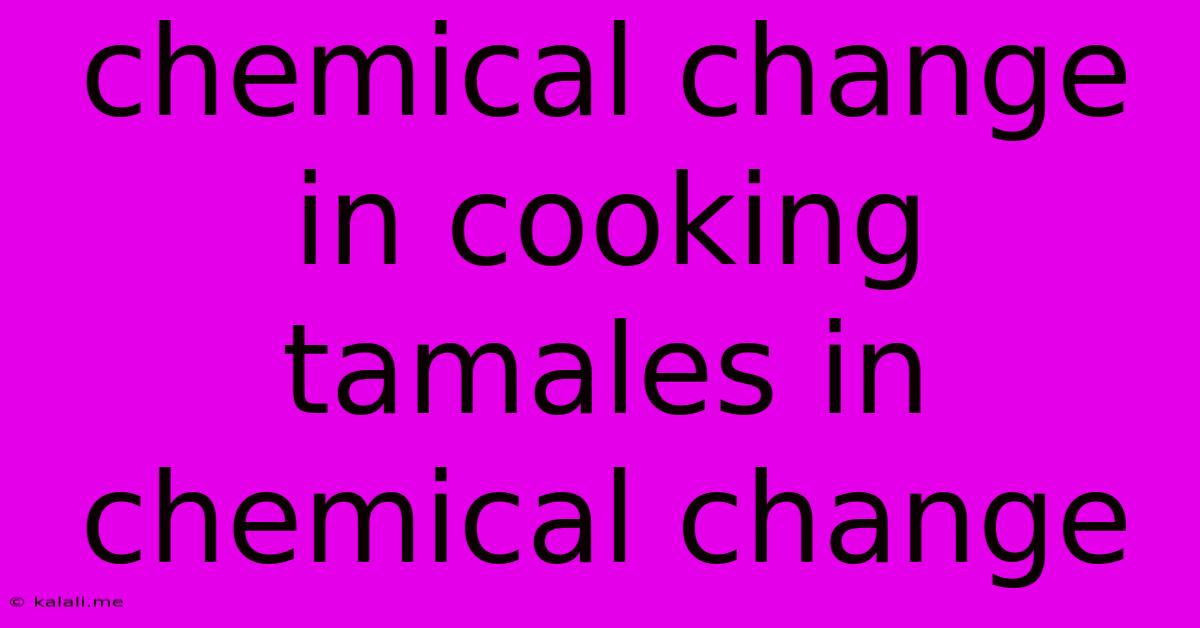Chemical Change In Cooking Tamales In Chemical Change
Kalali
Jun 10, 2025 · 3 min read

Table of Contents
The Chemistry of Cooking Tamales: A Delicious Chemical Transformation
Tamales, a culinary staple across Latin America, are more than just a delicious meal; they represent a fascinating example of chemical changes during the cooking process. This article will explore the chemical reactions involved in creating these savory pockets of goodness, focusing on the transformation of ingredients and the role of heat in achieving that perfect, steaming tamale. Understanding these processes helps us appreciate the culinary art and science behind this beloved dish.
What are the key chemical changes during tamale preparation? Several chemical changes occur, primarily involving the corn masa, the filling, and the cooking method (typically steaming).
The Maillard Reaction: Browning and Flavor Development
The hallmark of perfectly cooked tamales is their slightly browned, flavorful masa. This browning is due to the Maillard reaction, a chemical reaction between amino acids and reducing sugars. When the masa is heated, these compounds react, producing hundreds of different flavor and aroma compounds, contributing to the characteristic taste and color of the tamale. The extent of browning depends on the temperature and cooking time, with higher temperatures leading to more intense browning and a richer flavor profile (but also the risk of burning!). The presence of alkaline ingredients, like lime (nixtamalization), further enhances the Maillard reaction, leading to a deeper brown color and distinct flavor profile.
Gelatinization of Starch: The Structure of the Masa
Corn masa, the foundation of the tamale, undergoes a crucial chemical change called starch gelatinization. Starch granules in the corn flour absorb water when heated, swelling and eventually bursting, forming a viscous gel. This process is essential for the tamale's structure, binding the ingredients together and providing its characteristic texture. The temperature and cooking time directly influence the degree of gelatinization, impacting the final texture – too little heat, and the masa remains crumbly; too much, and it becomes gummy.
Protein Denaturation: Binding and Texture
Proteins within the corn masa and filling also undergo denaturation during cooking. Heat disrupts the protein's structure, causing it to unfold and coagulate. This process helps to bind the masa together, solidifying the tamale's shape and contributing to its overall texture. The denaturation of proteins in the filling ingredients also contributes to changes in texture and flavor, making them more palatable.
Cooking the Filling: Varied Chemical Transformations
The filling itself undergoes a series of chemical changes during cooking. For example, meat fillings experience protein denaturation, similar to the masa, resulting in a more tender and flavorful texture. Vegetables soften as their cell walls break down due to heat, releasing their flavors and nutrients. Spices release their aromatic compounds, contributing to the complex flavor profile of the tamale.
Steaming: The Gentle Cooking Method
The steaming process is crucial for even cooking and moisture retention. The steam transfers heat gently to the tamales, preventing burning and ensuring that the masa is cooked thoroughly without drying out. Steam also aids in the gelatinization of starch and denaturation of proteins, contributing to the final texture and flavor.
In Conclusion:
Cooking tamales involves a complex interplay of chemical reactions that transform raw ingredients into a culinary delight. Understanding these processes, including the Maillard reaction, starch gelatinization, protein denaturation, and the role of steaming, allows for a deeper appreciation of the science behind this beloved dish. By controlling the heat, time, and ingredients, cooks can fine-tune these reactions to achieve perfect tamales – a testament to the perfect blend of culinary art and chemistry.
Latest Posts
Latest Posts
-
What Are All The Factors Of 32
Jun 12, 2025
-
Isotopes Of An Element Differ In Their
Jun 12, 2025
-
What Five Colours Are In The Olympic Rings
Jun 12, 2025
-
Mass Of A Proton In Grams
Jun 12, 2025
-
Which Of The Following Is Not Caused By A Virus
Jun 12, 2025
Related Post
Thank you for visiting our website which covers about Chemical Change In Cooking Tamales In Chemical Change . We hope the information provided has been useful to you. Feel free to contact us if you have any questions or need further assistance. See you next time and don't miss to bookmark.